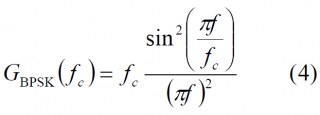If you wish to contribute or participate in the discussions about articles you are invited to contact the Editor
Binary Phase Shift Keying Modulation (BPSK)
| Fundamentals | |
|---|---|
| Title | Binary Phase Shift Keying Modulation (BPSK) |
| Author(s) | J.A Ávila Rodríguez, University FAF Munich, Germany. |
| Level | Advanced |
| Year of Publication | 2011 |
A very important and useful signal in satellite navigation is the BPSK modulation which was in fact the first one to be used for Satellite Navigation. In spite of its simplicity, it is still used nowadays but could eventually be substituted by the BCS modulation or combinations with this one in the medium-long term.
We will derive now the power spectral density of a BPSK(fc) using the general definition of BCS. According to this, any BPSK(fc) signal can be described as a BCS sequence with vector [math]\displaystyle{ \bar s }[/math]= [1 1 1 …1] whatever the length of the vector. We will derive the expression of the PSD generalizing over n.
First we build the [math]\displaystyle{ M^n \left ( \left [ \bar s \right ] \right ) }[/math] matrix for any n, which is shown to be:
According to this, the modulating function will be:
Once the modulating term has been calculated, the power spectral density can be expressed as follows:
After some maths (see GNSS Interference Model for details), expression (3) can be simplified to the well-known expression that we can find everywhere in the literature:
Credits
The information presented in this NAVIPEDIA’s article is an extract of the PhD work performed by Dr. Jose Ángel Ávila Rodríguez in the FAF University of Munich as part of his Doctoral Thesis “On Generalized Signal Waveforms for Satellite Navigation” presented in June 2008, Munich (Germany)




